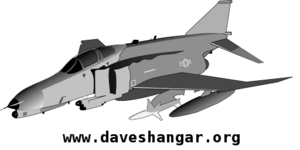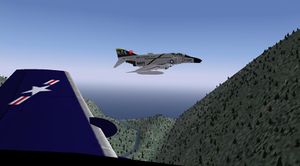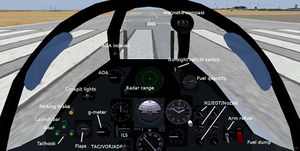McDonnell F-4 Phantom II
(Redirected from McDonnell F4 Phantom II)
Jump to navigation
Jump to search
 | ||
|---|---|---|
 | ||
| Type | Military aircraft, Interceptor aircraft, Fighter aircraft, Bomber aircraft | |
| Manufacturer | McDonnell, McDonnell Douglas | |
| Author(s) | Dave Culp | |
| FDM | JSBSim | |
| --aircraft= | F-4N | |
| Status | Unknown | |
| Development | ||
| Website |
| |
| Download |
| |
| License |
| |
| ||
|
| ||
The F-4 Phantom II (McDonnell, then McDonnell Douglas after 1967) is a tandem two-seat, twin-engined, all-weather, long-range supersonic jet interceptor fighter/fighter-bomber originally developed for the U.S. Navy by McDonnell Aircraft.
Before 1962 it used the Navy designation F4H.
Aircraft help
| Key | Function | Notes |
|---|---|---|
| l | Launch-bar-engage | For carrier-based variants only |
| C | Fire catapult | For carrier-based variants only |
| n | Toggle tailhook | For all variants |
| f | Toggle refueling probe | Refueling receptacle door on USAF and related variants. |
| m | Nose wheel steering | Hold this key down to get full steering range via rudder |
| Q | Toggle fuel cutoff switch | For selected engine(s) |
| R | Toggle reverse thrust | To facilitate parking on carrier deck |
| d | Deploy dragchute | Maximum speed is 210 knots |
| j | Jettison dragchute | |
| F | Toggle wing fold | For Navy variants |
| e | Release selected stores | |
| c | Toggle canopy | Pilot (forward) canopy only |
Startup:
The model is set to initialize on the ground with engines running, parking brake on, flaps up, canopy closed.
Configuring for takeoff:
Set flaps to full, release parking brake (runway launch) or engage launch bar (carrier launch).
Note: for light weight takeoff use flaps half.
Takeoff:
Full throttle. For carrier launch activate catapult. For runway launch rotate at 150 knots.
When airborne raise gear and set flaps to half. At 200 knots set flaps up.
Climb:
To save fuel, come out of afterburner at 350 knots. Climb at 400 knots then 0.9 Mach.
Descent:
Idle power, speedbrakes as necessary.
Configuring for landing:
Gear and flaps down below 250 knots. Retract speedbrakes. Hook down for arrested landing.
Final approach:
AOA on speed (about 140-150 knots). RPM about 85%. Descent rate about 700 fpm.
Field landing:
Throttle idle. Deploy drag chute. Brakes as required. Release drag chute when clear of runway.
Deck landing:
When stopped: Raise hook, fold wings, open canopy, raise flaps, follow marshaller's signals.
External links
http://en.wikipedia.org/wiki/F4_Phantom
| |||||||||||
